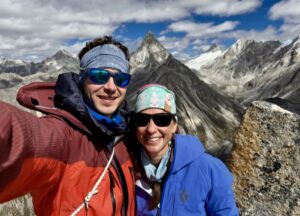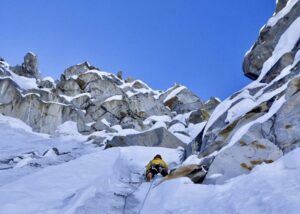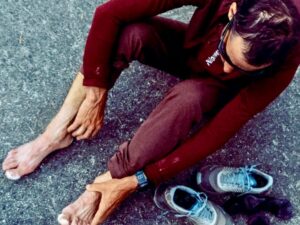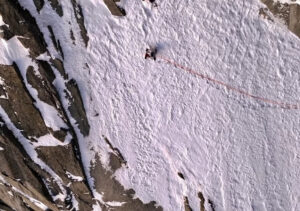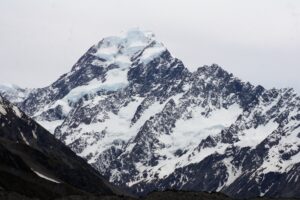Simply put, rock climbing grades describe the difficulty of a route. The main use of assigning route difficulty is to help other climbers judge whether it is suitable for their level.
But what goes into climbing grades, and why do they so often involve so many letters and numbers? Climbing is rife with technical jargon, and trying to decode the abbreviations can seem daunting.
However, always remember: climbing grade systems are devised by people who sleep in the dirt and live in caves. Each one is designed to be simple.

The author on an obscure attempt at aid climbing early in his career. Photo: Kurt Joseph
Note that this guide does not address bouldering grades — only roped climbing. For our purposes, the most prominent grade systems are:
- French Numerical System (6b+, 8a, etc.)
- YDS, or Yosemite Decimal System (3rd Class, 5.5, 5.11b, etc.)
- Commitment grade (III, VI, etc.)
- Aid rating (A2, A3+, etc.) or Clean Aid rating (C2, C3, etc.)
- Mixed grade (M4, M5 etc.)
- Water Ice grade (WI4, WI5+ etc.)
- Alpine System (F, ED, etc.)
What’s the point of climbing grades, and who gets to decide?
Before we dive into technical talk, here’s a PSA from our author and his researchers, dirtbags who’ve climbed more than a few rocks: Climbing grades are subjective. Like any sport, climbing is self-referential, and grade systems are improvisational at their core. Take them with a grain of salt. Their best use? Determining whether a route is within an acceptable safety margin for you to try.
It’s worth noting here that the difficulty of a climb is established by consensus. The first ascensionist, or first ascent team, gets the first crack at grading the route. After that, several other climbers generally weigh in after they’ve done it, too. Eventually, consensus gets established. How do we know how hard it actually is? We don’t, and the difficulty of a given route will seem different to every climber.
After you’ve accepted the method, consider that the surfaces of cliffs, mountains, and frozen waterfalls in ice climbing change constantly with weather and over time. Is there any way to tell whether the rock or ice is the same as it was when the route was graded? Many times, no.
In summary, it’s an imperfect system that often leads to disputes.

Sport climbers in Geyikbayiri, Turkey, home to over 850 routes across all grades. Photo: M. Selcuk Oren
Glossary of terms
- Route: the full length of a rock climb, from the bottom to the top. Some routes are 10m long; others are thousands of metres long.
- Pitch: the distance between two anchors on a route. A single pitch route is just that; from the ground to the first and only anchor. A climber could complete a 200m route in three pitches with a standard 70m rope. On some multi-pitch routes, each pitch gets its own difficulty grade. But every multi-pitch route gets an overall grade based on the hardest climbing on the route.
- Ropelength: a generalized term for vertical distance. Accepted to mean 60-70m.
- Belay: the act of protecting a climber using a rope and, often, a purpose-made device. If the climber falls, the rope “catches” the climber because the belayer and belay device hold it.
- Free Climbing: using only one’s hands and feet and the natural features of the rock for upward progress.
- Sport Climbing: free climbing, a route entirely protected by bolts. Maximizing physical and gymnastic difficulty is the point, as sport routes are seen as safe.
- Trad Climbing: “traditional climbing,” or free climbing a route while placing removable protection (such as cams or stoppers). Traditional climbing equipment is broadly called “gear.”
- Free Soloing: climbing alone, with no ropes or protection. A fall risks serious injury or death.
- Aid Climbing: pulling or standing on gear or hardware attached to the rock (like bolts, pitons, cams, nuts, etc.) for upward progress.
- Alpine Climbing: climbing in remote terrain, typically requiring long hikes and long, complex, and/or dangerous routes. Alpine climbers strive to climb as efficiently as possible, managing their own risk and safety margin.
- Lead Climber: the climber who ascends a pitch first and risks taking a lead fall onto the gear or bolts. The leader’s responsibility is to make it safely to the next belay station, then belay the follower up.
- Follower (or Second Climber): the climber who belays the leader from below on a multi-pitch. The follower’s responsibility is to protect the leader in case of a fall. Then, while (s)he climbs up, (s)he collects the gear the leader has placed while climbing.

Kari Strunk belays Nick Fuentes on the moderate hand crack ‘Sweat,’ 5.6. The ‘trad’ route requires cams or big stoppers for protection.
A brief history
In the beginning, there was the rock — and, at the time, pretty much just that. At first, climbing difficulty was purely a matter of oral history.

What rock climbing used to look like. Christine L. Reid climbs in the Dolomites in 1939.
Imagine you’re in 1870. For whatever reason, you’re looking at a rock face, thinking about climbing it. Not only does rock climbing equipment not properly exist, neither does the concept of “rock climbing,” let alone grades of difficulty. However, you can still climb the rock. Assume you do — who do you tell about it? Say it’s your brother Jebediah, who just came in from plowing the fields.
You: “Jebediah! Jebediah! I’ve just climbed a tall rock cliff!”
Jeb: “Why would you ever do that?”
You: “I don’t know, but it was great!”
Jeb: “Huh. Was it hard?”
You: (After a moment of consideration) “Sort of.”
Jeb: “How hard?”
You: “Ummm…”
Jeb: “Whatever. I must now separate the grain from the chaff.”
Thus in the dark ages, there was no reason to have a scale.
But by the 1890s, enough people were climbing that one Austrian man decided it was time for everyone to know how hard his climbs were.
That man, Fritz Benesch, generally gets credit for creating rock climbing’s first grading system in 1894. He used a simple scale of 1 to 7 to rate the difficulty of a climb. For some reason, he worked backward: the hardest route was a 1, and 7’s were easy or trivial.
That worked for a few years until somebody did a climb harder than a 1, which drove the scale to develop a 0 and eventually a 00.

The Welzenbach Scale, 1926.
Instead of continuing to 000 or (-1), German mountaineer Willo Welzebach inverted and shortened the Benesch scale in 1923. Welzenbach’s scale ran from 1 to 6, with 6 indicating that the climb could not be accomplished without aid (see Glossary of Terms above).
This system took off in French mountaineering circles, and in 1967, the UIAA (The International Climbing and Mountaineering Federation) made it the worldwide standard. At that time, it also incorporated Lucien Devies’ alpine scale and aid scale.
Today, the UIAA system is a reference point and corresponds broadly to multiple aspects of climbable terrain.
It’s no longer the most accurate way to describe the climbing difficulty. But it was a start, and it helped develop every system that’s still in use. The French Numerical System and the Yosemite Decimal System, predominant in the U.S., drew heavily on the original 1-6 scale.
French Numerical System (FR) — 6a+, 8b+, etc.
The French Numerical System (FR) is the dominant grading system for free climbing outside North America. ExplorersWeb has an international readership, and our contributors typically use FR when discussing technical ratings in articles.

A woman free climbs a multi-pitch big wall route. Photo: Shutterstock

The author on ‘Lal Bab,’ 7a+ at Tonsai Beach, Krabi, Thailand. Most international locations use the French grade scale.
FR rates a climb according to the overall technical difficulty and strenuousness of the route. Climbing grades start at 1 (very easy), and the system is open-ended. Grades 5 and higher can be further distinguished by adding a lowercase letter: a, b, or c. As well, a “+” indicates more difficulty (6a+ is harder than 6a but easier than 6b). Currently, the hardest route in the world is graded 9c.
Sometimes you’ll see an “F” in front of a French grade, as in “F7c+.” That’s simply a notation method, mostly used in the United Kingdom. For all intents and purposes, F7c+ = 7c+.
Yosemite Decimal System (YDS) — 5.6, 5.11a, etc.
YDS is the dominant classification system in the United States and parts of Canada.
Developed by the U.S.-based Sierra Club in the 1950s, the YDS unified and refined previous climbing grade systems from the early days of Yosemite Valley climbing. The YDS is subdivided into five classes according to technical difficulty.
Classes 1 and 2 relate to hiking and trail running; classes 3 and 4 designate easy scrambling up slightly inclined terrain, and Class 5 describes technical rock climbing.

A climber emerges from the top of a route on third or fourth-class terrain. Photo: Shutterstock
Class 5 ratings start at 5.0, which describes a low-angle incline requiring minimal skills. 5.15 is currently the top end. The official description for 5.15 terrain is “exceptionally difficult, often involving steep or overhanging rock that requires elite expertise, physical conditioning, and technical acumen.” Only elite climbers can handle 5.15.
Climbs rated 5.10 or harder may also carry a letter from a to d. For example, a route or pitch rated 5.10a is easier than a 5.10b. A 5.13 is harder than a 5.12d but easier than a 5.13a, etc.
The difficulty of Class 5 terrain is open-ended because the human capacity to climb harder rock routes continues to evolve. In the 1970s, Jim Bridwell expanded the YDS to include the 5.11 grade and implemented the letter system. This was necessary because a contingent of top athletes was pushing the limits of climbing like never before.

Kurt Joseph on the precarious crux of ‘Bolt Talk,’ 5.11a, Reimer’s Ranch, Texas. A solid example of 5.11 face climbing, the route featured sequential, technical movement on thin holds. However, it no longer exists — the wall collapsed in 2019.
A safety rating accompanies some YDS grades: notably, “R” or “X.” Note that a route’s technical difficulty does not determine the objective risk to the climber. Risk in climbing depends on various factors, including the abundance or scarcity of permanent hardware (e.g., permanent anchors, bolts, pitons), the quality of the hardware and the rock, and runout (the space between bolts or gear placements).

A climber runs it out at his home crag in Texas. Photo: Conrad Meave
In the YDS, safety is indicated by a suffix borrowed from the film industry:
- PG: generally safe, maybe the danger of a short fall onto a ledge or ground from a precarious first bolt or gear placement
- PG13: still little or no objective danger from a fall, but enough runout to raise concerns
- R: runout, injury is possible/probable in the event of a leader fall
- R/X: it’s not certain that the leader will die in a fall, but they might
- X: a leader fall is disastrous; certain to result in serious injury or death
(Sources: Bergefreunde; Moja Gear)
Supplemental grading systems
Free climbing isn’t the only type of climbing that is graded for difficulty. Aid climbing and various forms of ice climbing also require ratings for both the sport’s safety and its integrity.
In aid climbing, the leader uses bolts, pitons, or hardware placed in manufactured holes in the rock for upward progress — usually clipping into them with etriers, or rope ladders, and stepping up in the rungs.

Layton Kor aiding in Eldorado Canyon, 1963. Note the dangling, self-constructed etriers. Photo: Pat Ament
Ice climbing is exactly what it sounds like — climbing up pillars or walls of ice, usually from seepage or frozen waterfalls. Climbers use ice axes, crampons, and specialty ice screws to get the job done. Snow grades loosely follow the logic of ice grades.
But ice climbing isn’t always exactly that — sometimes, the ice runs out and leaves the climber with bare rock. When an ice climber uses their crampons and axes to climb on rock, it’s called dry tooling. The style of swapping freely between dry tooling and ice climbing depending on the terrain is called “Mixed.”
Terrain with potential for ice or mixed climbing. This climber chooses the continual ice flow, but they could also take a mixed route by climbing the exposed rock at the center of the frame, then transitioning into the stalactites above.
The somewhat dated but still useful alpine system gives a broad description of terrain most often applied to remote and complicated routes.
The Aid, and Clean Aid, grades — A1, A5, C2, C4, etc.

Aid climbing on steep terrain in the Swiss Alps near Glarus. Photo: makasana photo
The aid scale describes the difficulty of any climb where the leader uses artificial methods for progress.
The aid scale corresponds to both technical difficulty and objective danger. Because difficulty depends on the length and injury potential of a fall, harder climbing means gear placements are fewer, farther between, and/or lower quality.
For instance, A1 means a short distance between quality placements that won’t pull out even in a leader fall. A5 means every placement in an entire pitch (area between belay anchors, possibly over 60m) could rip out in the event of a fall.
If that sounds disastrous, it’s because it is. The A5 rating means that the leader will die if (s)he or she falls. Thankfully, many experienced climbers have never heard of an entire pitch ripping. Thus the existence of A5 is considered conjectural.
You might also see the “clean” aid scale: C1, C2, etc. Clean aid simply means there’s no permanent, unremovable or damaging hardware in the rock, such as bolts. Instead, the leader uses trad gear (see Glossary of Terms above) to aid upward progress, and the follower removes them as (s)he climbs up.
Otherwise, the concepts between aid and clean aid grades are identical.
- A1: Easy aid. No risk of a piece pulling out.
- A2: Good gear with more difficult placements.
- A2+: 10m fall potential from tenuous placements, but without danger.
- A3: Hard aid. Many tenuous placements in a row; 15m fall potential; time-consuming.
- A3+: A3 with dangerous fall potential.
- A4: 30m ledge-fall potential with continuously tenuous gear.
- A4+: Greater fall potential and greater technical difficulty, where each pitch could take many hours to lead.
- A5: Extreme aid. A climber can trust nothing on the entire pitch to hold a fall.
- A6: A5 climbing with belay anchors that won’t hold a fall either.
Water Ice Climbing grades — WI3+, WI6, etc.
Water ice grades describe the difficulty of climbing performed entirely on ice. Due to how widely the character of ice can vary from year to year, water ice grades should be regarded as approximate.

Ice climbing in Canada. Note that many factors can cause the climbing medium to change. Photo: Hermann Erber
Also, “water ice” exists seasonally. It’s possible but increasingly rare to see “alpine ice” grades (AI3+, AI6, etc.), which denote year-round ice.
- WI1: Low angle ice; no tools required.
- WI2: Consistent 60º ice with possible bulges; good protection.
- WI3: Sustained 70º with possible long bulges of 80º-90º; reasonable rests and good stances for placing screws.
- WI4: Continuous 80º ice fairly long sections of 90º ice broken up by occasional rests.
- WI5: Long and strenuous, with a rope length of 85º-90º ice offering few rests or a shorter pitch of thin or bad ice with protection that’s difficult to place.
- WI6: A full rope length of near-90º ice with no rests or a shorter pitch even more tenuous than WI5. Highly technical.
- WI7: As above, but on thin, poorly bonded ice or long, overhanging, poorly adhered columns. Protection is impossible or very difficult to place and of dubious quality.
- WI8 and above: Amounts to hard bouldering on a rope, using ice tools and crampons, often with bolts as protection. See below to check out Mission to Mars, the world’s hardest ice route at WI13.
Snow grades are similar to water ice grades but simpler: Snow climbing grades typically depend on the angle of the snow and nothing more. It can either be a range (60º-70º) or a reading at the steepest point (70º).
Mixed Terrain Climbing grades — M1, M8, etc.
Mixed terrain grades go from M1 (low-angle terrain that usually requires no ice axes) to M12 (steep terrain with gymnastic moves on tenuous holds). Routes graded M13-16 exist, but difficulty within that range is considered conjectural.
The hardest mixed climbing defies attempts to quantify, even to its authors. Canadian Will Gadd put up what’s considered the hardest mixed route in the world, at Helmcken Falls in British Columbia. Asked about the grade, he said: “I don’t even try to grade these things. I haven’t for a couple of years now. They are what they are. If you can do it, you get to the top, and if you can’t, you fall off. That’s good enough for me.”
Overhanging terrain starts at M7. Does climbing overhanging rock smeared with ice while wielding axes and wearing spiked shoes sound horrifying? If so, your instincts are correct, but that’s the name of the game: Hard mixed and ice climbing is horrifying.

Kristoffer Szilas climbing a mixed route in Italy. Photo: Ramon Marin
Here’s the full scale:
- M1-3: Easy. Low angle; usually no tools.
- M4: Slabby to vertical with some technical dry tooling.
- M5: Some sustained vertical dry tooling.
- M6: Vertical to overhanging with difficult dry tooling.
- M7: Overhanging; powerful and technical dry tooling; less than 10m of hard climbing.
- M8: Some nearly horizontal overhangs requiring very powerful and technical dry tooling, bouldery or longer cruxes than M7.
- M9: Either continuously vertical or slightly overhanging with marginal or technical holds, or a horizontal roof with plentiful tool placements of two to three body lengths.
- M10: At least 10m of horizontal rock or 30m of overhanging dry tooling with powerful moves and no rests.
- M11: A rope length of overhanging gymnastic climbing, or up to 15m of roof.
- M12: M11 with bouldery, dynamic moves and tenuous, technical holds.
- M13-M16: Conjectural. The world’s hardest mixed route, by Will Gadd and others at Helmcken Falls, BC, Canada, is ungraded.
The Alpine Climbing Grade System — F, A, TD, etc.
Though in some ways rudimentary, the alpine system can still help describe a long or remote route’s overall difficulty. It consolidates various factors like approach and descent, altitude, danger, and commitment to assess the total experience in a one- or two-letter rating. It is somewhat rare, but it can be beneficial for new routes. If and when the first ascent team doesn’t come away with a pitch-by-pitch description of the route’s difficulty, the alpine system comes into play.
- F: Facile/easy. Rock scrambling or easy snow slopes; some glacier travel; often climbed ropeless except on glaciers.
- PD: Peu Difficile/a little difficult. Some technical climbing and complicated glaciers.
- AD: Assez Difficile/fairly hard. Steep climbing or long snow/ice slopes above 50º; for experienced alpine climbers only.
- D: Difficile/difficult. Sustained hard rock and/or ice or snow; fairly serious stuff.
- TD: Très Difficile/very difficult. Long, serious, remote, and highly technical.
- ED: Extrèmement Difficile/extremely difficult. The most serious climbs with the most continuous difficulties. Increasing levels of difficulty indicated by ED1, ED2, etc.
Climbing commitment grades
A few varieties of commitment grades exist. Here’s what you need to know:
- Commitment grades are designed to give climbers an idea of how long it will take to complete a route.
- The NCCS system is the de facto worldwide standard for commitment grades.
- The Alaska system only applies in (you guessed it) Alaska.
- Same for the Canadian Winter grade.
NCCS commitment grades — III, VI, etc.
The National Climbing Classification System (NCCS) bases time commitments on how long an “average” climbing team will be on the route.
- I: one to three hours
- II: three to four hours
- III: four to six hours
- IV: a full day of climbing, often mildly technical (usually eight to 12 hours)
- V: requires one overnight
- VI: two or more days but less than a week total
- VII: a long and major big wall expedition, usually in remote locations and lasting a week or longer
Alaska climbing grades — 2, 3, etc.
The Alaska system helps climbers prepare for the region’s unique weather patterns, where climbing in storms is common.
- 1: Easy glacier travel.
- 2: Not technical climbing, but dangerous because exposed to knife-edged ridges, weather, and altitude.
- 3: Moderate to hard, including some technical climbing.
- 4: Hard to difficult.
- 5: Difficult, with sustained climbing, high commitment, and few bivouac sites.
- 6: Sustained hard climbing over hundreds of vertical metres; high commitment.
Canadian winter climbing commitment grade — II, IV, etc.
The Canadian winter commitment system is similar to the NCCS but specific to climbing in, well, the winter months in Canada. We include it here because climbers do occasionally use it.
- I-II: 1 or 2 pitches near the car, but may need to be avoided during avalanche season.
- III: Requires most of a day, including the approach, which may require winter travel skills (possible avalanche terrain, placing decent anchors).
- IV: A multi-pitch route at a higher altitude or remote location. Multi-hour approaches in serious alpine terrain.
- V: A full-day climb in alpine terrain with a long approach, long technical descent, and objective dangers.
- VI: A long waterfall with the character of an alpine route; formerly required at least a day to complete, now often done faster. Significant alpine objective hazards.
- VII: Under discussion.
Conversion chart of all 10 climbing grade systems
Here’s a comprehensive grade conversion chart, courtesy of the equipment brand, Bergefreunde.
Note that we’ve omitted some rarely seen scales for brevity and that the only climbing grades worth comparing are those that rate free climbing. This chart accurately compares the French scale with the YDS, but neither of those scales accurately corresponds with aid or water ice grades. In fact, water ice grades don’t compare to aid grades or vice versa.
It is possible to relate high-standard water ice and mixed grades to free climbing difficulty, but only abstractly. Using tools and crampons on rock is a lot different than using one’s hands and feet.
For additional information about the alternative climbing grade systems not discussed here, refer to the additional resources section at the bottom of this page.
Climbing grade ratings applied
In our climbing stories, you’ll never see a rating below 1 on the French Numerical scale (or 5th Class on YDS) because that is just scrambling.
You may see 6b+ (5.10d YDS), which means the climb is upper-level intermediate, within an experienced, generally fit, and technically literate climber’s abilities.

‘Missing Snow’ 6b (5.10c), Tonsai, Krabi, Thailand. Photo: Sam Anderson
8a (5.13a YDS) is considered advanced. 9a (5.14d YDS) is the international climbing grade standard for elite free climbing. Many Olympic-caliber climbers send 9a or harder, but it is rare for climbers who don’t get paid to do it.

Ceuse, France is legendary for hard sport climbing. Among many hard routes, Alex Megos’ ‘Bibliographie,’ 9b+ (5.15c) is here. Photo: Shutterstock
Alpine routes generally incorporate more supplemental ratings, as mountain terrain varies heavily over long and complex routes. Recently, ExWeb referenced the late David Roberts’ The Southeast Face of Mount Dickey (Alaska Grade VI, 5.9 A3). The grade notes mean the route’s overall texture is “sustained, hard climbing over thousands of vertical feet.” It involves free climbing up to 5.9 and aid climbing up to A3.
Conversely, Roberts’ Harvard Route is graded WI3, M6, C1, Steep Snow. Establishing a free climbing grade can be difficult on some alpine routes due to changing terrain and weather, so some climbers don’t assign one. “Steep snow” could be seen as an archaic term, but you can get an idea of what to expect from the “vertical to overhanging” mixed terrain and 70˚ ice.
Upper echelon: the hardest climbing in the world
Of course, an open-ended system describing difficulty in a sport that constantly evolves begs one thing: What’s the upper limit? Here’s the most outrageous terrain (and by turn, the biggest numbers) as of late summer 2021.
Hardest sport climbing
Adam Ondra’s unrepeated Silence (9c/5.15d) is currently the hardest route in the world. Here’s Ondra discussing why he gave the route in Flatanger, Norway 9c.
However, the climbing grade awaits confirmation. Alex Megos’ Bibliographie, in Ceuse, France, was also 9c. But last week, Italian Stefano Ghisolfi repeated it and downgraded it to 9b+ (5.15c) based on other routes of that grade that he’s done.
To communicate how desperate 5.15 climbing really is, Ghisolfi shot a close-up of one of his attempts on Bibliographie. (Skip to 4:20 for max gnar factor.)
Hardest big wall climbing

El Cap in Yosemite, the Mecca of big wall climbing worldwide. Photo: Shutterstock
The Dawn Wall, by Tommy Caldwell and Kevin Jorgeson, is widely considered the world’s hardest big wall route. It takes 32 pitches up the east face of El Capitan at 5.14c (8c+).
Only five pitches on the route are easier than 5.12, and six are 5.14 or harder. Caldwell, one of the world’s best wall climbers, spent seven years trying the route before he succeeded. Notably, Ondra repeated it on his first trip to Yosemite.
Hardest alpine climbing
Determining the hardest alpine climb in the world is a little bit like identifying the hardest way to get to the moon. Where do you start, and what are the parameters? There are so many factors that can make alpine climbing hard: remoteness, logistics, technical difficulty, terrain or weather, and information available beforehand all make huge differences.
Because of the complexity of the challenges, it’s not nearly as easy as pointing to the highest number. And because of its exploratory nature, the state of the sport is perhaps best defined by what’s considered possible but hasn’t yet been completed.
To get an idea of what constitutes cutting-edge alpine climbing today, check out this guide by ExWeb’s Ash Routen. With thorough descriptions, the article consolidates a handful of the highest-standard alpine routes that remain unclimbed.
Hardest ice climbing
At the moment, there’s only one WI13 in the world. Mission to Mars, by Tim Emmett and Klemen Premrl, is at Helmcken Falls in Canada. Even if you’re not into ice climbing, the video’s worth a watch for the mind-blowing setting, camera work, and athletic prowess.
Additional resources for climbing grades
A detailed explanation and comparison of all 10 climbing classification systems by Bergfreunde
Rock Climbing Glossary, published and maintained by REI
Explanation of the A1 to the A5 grading system for aid climbing pitches by John Middendorf


